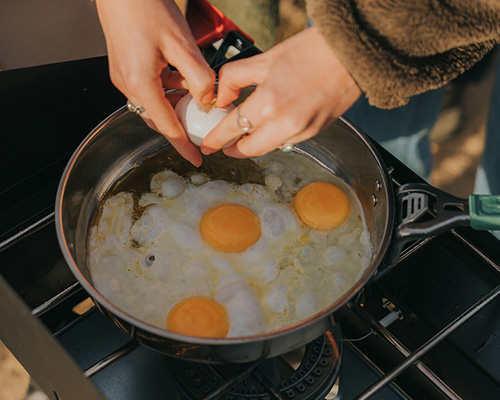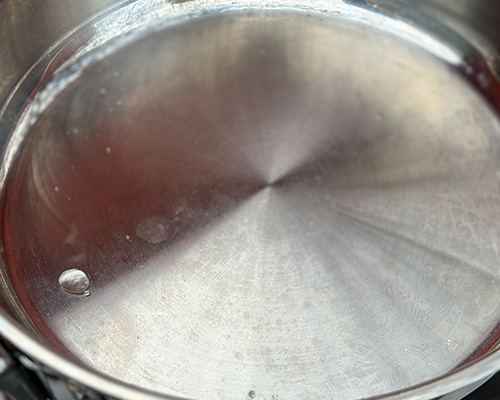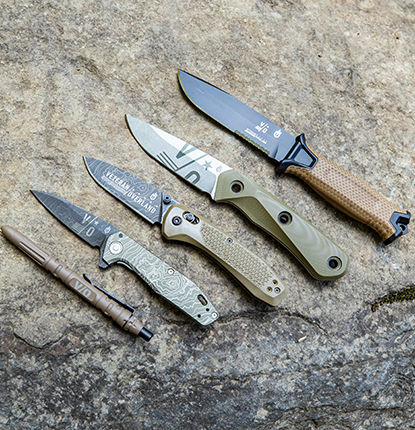In the world of pots and pans, there are many options. But time after time, you’ll often see a seasoned cook grab a stainless steel pot or pan. Stainless steel is the backbone of many good meals, versatile, durable, nonstick, and downright reliable. However, it can be difficult if you don’t know how to use one. That’s why it’s essential to know how to make a stainless steel pan nonstick.
When properly heated, the pan is nonstick, cooks evenly, and, most importantly, is easy to clean. It’s a big reason why we made our ComplEAT Cook Set with 3-ply stainless steel, making it easier to make a great meal out at camp and easier to clean up once it’s all said and done. So, follow along as we learn how to make a stainless steel pan nonstick.
The Science of Heating Stainless Steel
Stainless steel is an amazing material for cooking because of the way it conducts heat. It has a high thermal conductivity, which means it can heat up quickly and distribute that heat evenly. This is important for you when you’re cooking at camp, because you don’t want to spend forever cooking, and you don’t want any burn spots on your food. It also helps you control the temperature well so you can have a better grasp of your cooking.
You may have heard the term “Hot pan, cold oil” as a method to make sure your pan is nonstick. This is indeed a method that works, but it is also a bit of a myth. The idea is that you heat up that pan without any oil, and once it’s hot, you add oil and then your food, and this makes it nonstick. The truth is your oil heats up almost instantly when you add it to the pan. So, it’s not cold. You could heat up oil with the pan, but you’re more likely to reach your oil’s smoking point.
What makes stainless steel nonstick is that when it heats up, the metal expands slightly, the oil you add fills in those gaps and lets your food cook and sit up on top of it.
Steps to Properly Heat Your Pan

- Select the Right Burner:
Make sure your burner is about the same size or a bit smaller as your pan, this will ensure you can get an even amount of heat.
- Initial Heating:
Place the pan on your stove and set to medium heat. If you’re using a two-burner camp stove, you may need to learn what medium heat feels like. No burner is the same, and camp stoves often burn much hotter than those in your home kitchen. So, a medium heat could look like a low heat on your burner.
Once you’ve got your heat set, leave it for about 3 to 5 minutes.
- Testing the Temperature:
Using the water droplet test is one of the easiest (and most satisfying) ways to test if your pan is hot and ready to cook.
Add a few drops of water to your pan.
If the water instantly sizzles and starts to evaporate, it’s not done heating up!

If you add the water and the droplets stay in tiny balls and begin to dance around the pan, it’s ready for cooking.

- Adding Oil:

Now, you’re ready to add your oil. What oil you use is dependent on what you’re cooking and what recipe you’re using, but you should familiarize yourself with the smoking point of cooking oils. For instance, olive oil has a low smoking point, while canola oil has a high smoking point. So, if you’re going to sear something like a steak, canola oil will probably be the right oil to choose.
Common Mistakes to Avoid
Avoid these mistakes when heating up your pan. Don’t try to cut corners, and heat up your pan on high heat. You want to take your time so it’s even and consistent.
Don’t add your food until you know the pan is ready. Adding your food too quickly will make your food stick to the pan and cancel out the whole purpose of a stainless steel pan.
Using too much oil or not enough. Find the right balance. Too little oil and there won’t be enough coverage to cook your food and make it nonstick. Too much, and you may be deep frying your food when you want to sauté.
Tips for Maintaining Your Pan’s Performance
The more you use your pan, the more you’ll need to maintain it. While the ComplEAT Cook Set is dishwasher-safe, you’re better off if you stick to handwashing and hand-drying stainless steel. This will also help keep a natural seasoning on the pan that will improve further use.
It’s also important to let your pan cool down on its own. Temperature shocks, placing it into cold water can weaken the steel and hamper its performance in the long run.
Now you’re all set and know how to make a stainless steel pan nonstick. Use this method before your next camp cook session to get the best out of your cookware. Make sure to browse the camp recipes we have listed on the blog.






